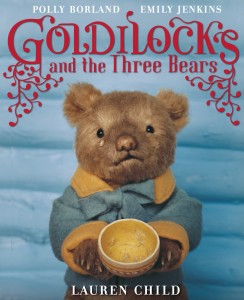by Lauren Child, photography by Polly Borland, styling and set creation by Emily Jenkins
(Ages 3-6)
Lauren Child enlivens a time-honoured classic.
 New editions of fairy tales generally fall into one of two categories. Some dress the tales in olde worlde language and traditional illustrations—such as Jane Ray’s lyrical Twelve Dancing Princesses. Others opt for inventive modern departures from the original, replete with cyber-references—such as Bleeping Beauty by Laurence Anholt, featuring a princess addicted to computer games. Though I enjoy both genres, I am delighted that Lauren Child opted for a third, more unusual approach in retelling Goldilocks and the Three Bears. Child remains faithful to the original story line, but uses the cheeky, arch tone we expect from the creator of the Charlie and Lola and Clarice Bean series.
New editions of fairy tales generally fall into one of two categories. Some dress the tales in olde worlde language and traditional illustrations—such as Jane Ray’s lyrical Twelve Dancing Princesses. Others opt for inventive modern departures from the original, replete with cyber-references—such as Bleeping Beauty by Laurence Anholt, featuring a princess addicted to computer games. Though I enjoy both genres, I am delighted that Lauren Child opted for a third, more unusual approach in retelling Goldilocks and the Three Bears. Child remains faithful to the original story line, but uses the cheeky, arch tone we expect from the creator of the Charlie and Lola and Clarice Bean series.
Her Goldilocks is vivacious, a touch vain, and far too curious for her own good. Which is how she comes to be wandering alone in the woods in the first place:
Her mother often worried about letting Goldilocks out of her sight, but sometimes the little girl would ask just one too many questions and stick her fingers in one too many saucepans. And her mother, unable to bear it any longer, would send her out to collect firewood.
Later, when Goldilocks stumbles upon the Bears’ house, she comments:
I know, it’s strange to have bears living in a little wooden cottage, but this is a fairy tale and strange things happen in fairy tales.
Since fairy tales are rooted in an oral tradition, I think it’s fair game for a modern writer to stamp a bedtime favourite with her original narrative voice. Further, Child’s accessible, conversational style highlights the ongoing relevance of this classic story.
No museum piece, Goldilocks, like other fairy tales, addresses anxieties and aspirations that remain central to modern children. My son adopted Child’s version of Goldilocks as his personal talisman in the run-up to new baby. As we readied our house for the arrival of said Dubious Intruder, my son would enact the role of Baby Bear to reassure himself of our ongoing protection. Now that he’s adjusted to big brother status (and the attendant privileges of seniority) it’s fun to watch him tuck into his morning porridge with an appreciative Papa Bear growl.
Child’s sharp, yet faithful text partners beautifully with striking, detailed stills by set designer Emily Jenkins and photographer, Polly Borland. Like the text, the artwork is faithful to the original storyline. The bears inhabit a rustic log cabin, complete with beehives– not a Conran-style city pad—and porridge is cooked on an Aga that pre-dates Quaker’s Oat so Simple range. But the sharp digital prints, and occasional modern touches – such as Baby Bear’s toy alien and car – suit Child’s contemporary tone. No sepia or soft focus allowed.
By putting the fun back into a stock tale that has been frumpified over the years, Child, Jenkins and Borland inspire the to join in. This book prompted our family to attempt our own rough-and-ready Goldilocks slide show starring three well-worn cuddly toys and our tow-haired neighbour – highly recommended as a snow day activity for a snap-happy mamma bear and her hibernating cubs.
PS. To see how fairy tales evolve over time, I recommend the first published version of Goldilocks, Robert Southey’s The Three Bears (1837). Southey recounts that an “ impudent, bad old woman” devours “Little, Small, Wee Bear’s” porridge, vandalizes the house, and meets with an uncertain end, for, “whether she broke her neck in the fall or ran into the wood and was lost there, or found her way out of the wood and was taken up by the constable and sent to the House of Correction for a vagrant as she was, I cannot tell.” Fortunately, we live in kinder, gentler times.
Mums Write! Book Pick, May 2012

2 Responses to Goldilocks and the Three Bears